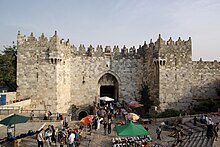Gates_of_the_Old_City_of_Jerusalem
Gates of the Old City of Jerusalem
Historical entrances through the Walls of Jerusalem
This article lists the gates of the Old City of Jerusalem. The gates are visible on most old maps of Jerusalem over the last 1,500 years.
2. Zion
3. Dung
4. Golden (walled up)
5. Lions
6. Herod
7. Damascus
8. New Gate
Quarters:
During different periods, the city walls followed different outlines and had a varying number of gates. During the era of the crusader Kingdom of Jerusalem (1099–1291), Jerusalem had four gates, one on each side.[citation needed]
The current walls of the Old City of Jerusalem were built between 1533 and 1540 on orders of Ottoman Sultan Suleiman the Magnificent, who provided them with seven gates: six new gates were built, and the older and previously sealed Golden Gate was reopened (only to be re-sealed again after a few years). The seven gates at the time of Suleiman were, clockwise and by their current name: the Damascus Gate; Herod's Gate; Lions' Gate; Golden Gate; Dung Gate; Zion Gate; and Jaffa Gate.
With the re-sealing of the Golden Gate by Suleiman, the number of operational gates was only brought back to seven in 1887, with the addition of the New Gate.
Until 1887,[citation needed] each gate was closed before sunset and opened at sunrise.







